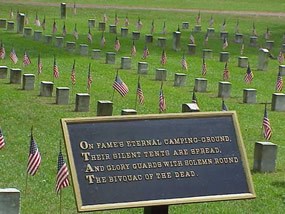By Kathleen Walls/Contributing Editor
Publisher of American Roads and Global Highways
The Corinth Civil War Interpretive Center was built on the battlefield site of Battery Robinett, one of the Union’s primary defense positions. A good place to start is with the video in the center’s theater. It explains the reason Corinth was such an important point in the Civil War. Two railroads: the Memphis and Charleston Railroad running east and west and the Mobile and Ohio Railroad running north and south were the Confederacy’s supply line. For victory, they had to hole it at all costs. The Union needed to cut that line to win the war.

After the video, step outside and view the fountain. (above header) The fountain tells the first hundred years of United States history from an artistic point of view. Dates run along the side of the pool. The stone rising out of the pool has parts of the Declaration of Independence and Constitution representing the beginning of a new nation. Thirteen waterfalls representing the 13 colonies flow into one stream which represents the new nation. Following the fountain down new states represented by new stones are placed. As a state enters the union they have to decide whether they are slave or free. The slave states, mainly southern states, are depicted on one side of the stream and free states, mainly northern on the other. (Do not forget that all slave states did not join the Confederacy. Four slave states; Kentucky, Tennessee, Maryland, and Missouri; fought for the Union). The red square stones represent conflicts. At the point marked 1861, the start of the Civil War, the water becomes congested and slopes downward and splits into two streams. About 50 battles and campaigns are represented in the water by different sized square stones. The sizes represent the battles with the largest casualties. At the end of the pool, the two sections come back together representing the end of the war.
At the far end of the fountain there are blocks representing three new amendments; the 13th freeing all slaves, 14th granting citizenship to former slaves, and the 15th granting the right to vote to Black men. This is called Reunification Bridge. The plaque here reads “The Civil War was fought over issues of liberty. The cost was high and many of these issues remain to be resolved.”

The Center’s museum’s exhibits detail the story of both the battle of Shiloh and Corinth. Ironically, Shiloh, one of the bloodiest battles of the war at this point was mainly to capture Corinth. The first actual battle was a siege lasting from April 29 to May 30, 1862 resulting in a Union victory at Corinth after the Union took Shiloh. On October 3 and 4, 1862, the Confederates tried unsuccessfully to retake Corinth.
The Contraband Camp
About 2 miles east of the interpretive center is a park dedicated to some of the positive results of the Civil War, The Contraband Camp. With Corinth in Union hands, African American seeking freedom fled to the Corinth where the Union army protected them as “contraband of war.” Former slaves built their own town complete with cabins, a church, school, and hospital.
They grew crops and for the first time shared the profits. Now they were paid for labor once preformed for free. The camp would have accommodated several thousand people and had over 400 acres of crops. No known photograph of the camp is in existence today. The name “Contraband” was the standard term used in reference to runaway slaves during the war. Since under the current U.S. constitution they were still considered property, they could not yet be called Freedmen.

The “Camp” today has no remnants of the original camp that once existed there but artist Larry Luger created six life-size bronze statues to represent life in the Camp along a quarter-mile walkway. The entranceway sculpture shows a woman leaning against a fence welcoming other contraband. Other statures along the walkway include a laundress ironing clothes, a woman teaching a child to read, a Black farmer, a USCT soldier, a boy handing books to the camp chaplain.
There are few records remaining about camp residents except for the 1,000 men who joined 1st Alabama Regiment of African Descent, later called the USCT (United States Colored Troops. One of those soldiers was a man named Jerry Suttor, who was an ancestor of former first lady Michelle Obama.
In December 1863, the camp was abandoned and residents moved to Memphis.
Shiloh Battlefield
Shiloh is about a half-hour drive from Corinth across the Tennessee line. The video there, Fiery Trial, recreates the battle and events leading up to it. The Visitors Center Museum in Shiloh is larger and more detailed than the one in Corinth.
The battlefield is the most fascinating part of the park. The Visitors Center has a self-guided 12-mile auto-tour with marked stops at battle sites. You visit the Peach Orchard. The fighting occurred here in the early afternoon of April 6th. Each side created lines stretching almost three miles. The Union had been driven back into a defensive position. Confederate General Albert Sidney Johnston was trying to force the Union troops away from the Tennessee River. The monuments and cannon exhibits at this site mark the Union line.
It was near the Peach Orchard around 2:45 PM that Confederate General Albert Sidney Johnson was shot in his right knee. The bullet severed an artery and he bled to death. Johnson had ordered his personal physician to tend to both Union and Confederate dead earlier so no one noticed the wound. Johnson had no feeling in that leg due to an earlier wound.
General Johnston’s death site is marked by a monument. Johnston was the highest-ranking officer, on either side, to die in the Civil War. General Pierre Beauregard became commander of the Southern Army after Johnston’s death.
There are markers and stops marked on the map for these and other important spots, 20 in all.
My favorite stop is the replica of the Shiloh Church from which the battle took its name. The church you see is a replica completed in 2001 and based on historical records. The original church only survived the battle for a few weeks until it fell apart due to damages sustained in the battle. In the interim it served as a hospital after the fighting. General Sherman’s headquarters were near the Shiloh Church. After the Union army had been forced into a retreat and many surrendered, General Beauregard, set up his headquarters near the church. Beauregard, believing the Union was defeated, sent a telegram to President Davis proclaiming a Confederate victory. The following morning when Union reinforcements turned the battle, Beauregard directed the retreat to Corinth from here. That telegram was one of the big reasons Lee became the leader of the Confederate forces later and Beauregard was never again the top general.

Across the street from the church is the Shiloh Cemetery. Most graves date from the early 1900s but there are some new ones. Much of the fighting in this part of the battle occurred in this cemetery. Cannon mark the locations of artillery placement. There are 3584 Union dead of which 2357 are unknown, and two Confederate graves. The Shiloh Indian Mounds National Historic Landmark is located on battlefield grounds.
 Extended Weekend Getaways
Extended Weekend Getaways